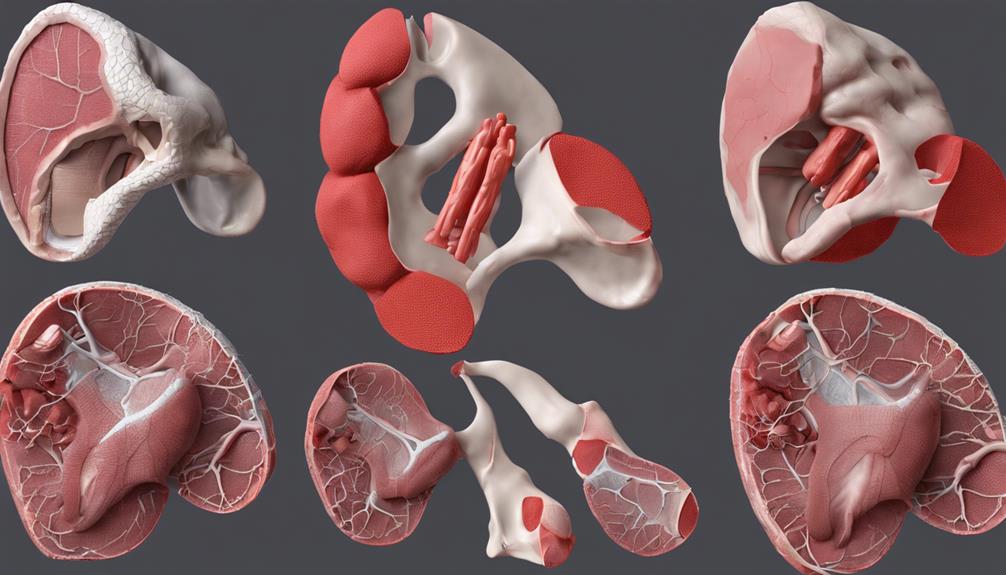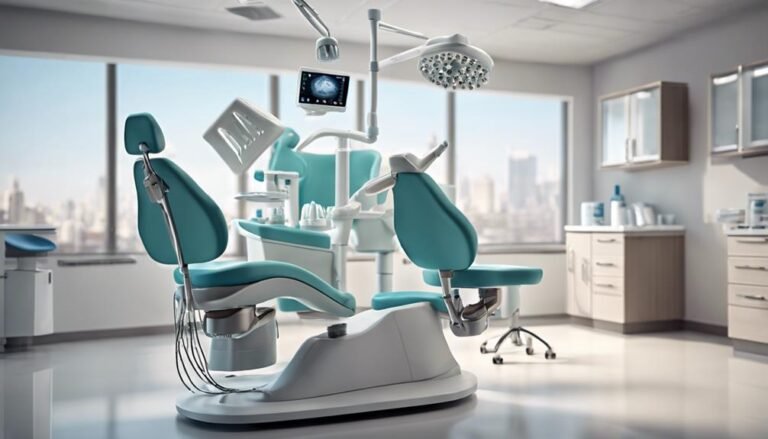Vascular Grafts Review: The New Age of Vascular Surgery
Discover the revolution in vascular surgery through advanced vascular grafts. Modern designs offer improved flexibility, durability, and compatibility. Materials like ePTFE and Dacron enhance biocompatibility, extending graft longevity. Surgical techniques focus on meticulous preparation, precise suturing, and vigilant post-operative care. Proper graft size and material choice are essential for best outcomes. Benefits include enhanced durability, biocompatibility, and surgical precision. Explore nanotechnology applications, bioresorbable grafts, and future trends for a glimpse into the evolution of vascular graft technology.
Key Takeaways
- Innovative designs and advanced materials improve durability and flexibility of vascular grafts.
- Hybrid grafts combining synthetic and biological components for enhanced benefits.
- Nanotechnology applications enhance graft functionality and biocompatibility.
- Continuous monitoring post-implantation ensures graft functionality and longevity.
- Future trends include nanotechnology, gene therapy, robotic assistance, and advanced imaging technologies.
Evolution of Vascular Grafts
As vascular surgery advanced over the years, the evolution of vascular grafts has played an essential role in improving patient outcomes and treatment options. Innovative designs and advanced materials have revolutionized the field, leading to better results and increased longevity of grafts.
Innovative designs refer to the new ways in which vascular grafts are constructed, allowing for improved flexibility, durability, and compatibility with the body's natural structures. These designs have been pivotal in enhancing the overall performance and success rates of vascular graft procedures.
Advanced materials, such as expanded polytetrafluoroethylene (ePTFE) and Dacron, have significantly contributed to the longevity and efficacy of vascular grafts. These materials offer improved biocompatibility, reduced risk of infection, and enhanced strength, making them ideal choices for various surgical applications.
Types of Vascular Graft Materials
The advancement in vascular surgery techniques has led to the utilization of various types of materials for vascular grafts, each offering unique characteristics and benefits. When considering vascular graft materials, it's essential to compare their properties and understand the innovation trends shaping their development. The choice of graft material profoundly impacts implant performance and long-term outcomes for patients undergoing vascular surgery.
- Synthetic Materials:
- Dacron and expanded polytetrafluoroethylene (ePTFE) are commonly used due to their durability and biocompatibility.
- Biological Materials:
- Such as autologous vein grafts or tissue-engineered grafts, offer better integration but may have limited availability.
- Hybrid Grafts:
- Combining synthetic and biological components to leverage the benefits of both materials.
- Nanotechnology Applications:
- Innovations in nanomaterials are enhancing graft functionality and biointegration.
- Bioresorbable Grafts:
- Grafts that gradually degrade over time, promoting tissue regeneration and reducing long-term complications.
Surgical Techniques for Graft Implantation
When implanting vascular grafts, you'll need to evaluate various methods. Confirm the compatibility of the graft with the recipient's anatomy is carefully assessed.
Be prepared to address potential complications and have mitigation strategies in place.
Implantation Methods Overview
Utilize precise incision techniques for ideal vascular graft implantation. When considering implantation methods for vascular grafts, several novel techniques and innovative approaches have emerged to address implantation challenges and leverage recent surgical advancements.
To guarantee successful graft implantation, follow these key steps:
- Careful Preparation: Thoroughly prepare the surgical site to minimize the risk of contamination and infection.
- Proper Suturing: Use high-quality sutures and ensure precise and secure suturing to promote excellent healing and reduce the likelihood of leaks.
- Hemostasis: Achieve effective hemostasis to prevent excessive bleeding and maintain a clear surgical field during the implantation process.
- Gentle Handling: Handle the vascular graft with care to avoid damage to the delicate structure and maintain its functionality.
- Monitoring: Continuously monitor the graft post-implantation to assess its functionality and guarantee proper integration within the vascular system.
Graft Compatibility Considerations
For ideal outcomes in vascular graft implantation, meticulous consideration of graft compatibility is paramount in guaranteeing successful surgical techniques. When selecting a graft for a vascular procedure, factors such as graft sizing and material play a vital role in the long-term success of the surgery. Proper graft sizing ensures ideal blood flow and reduces the risk of complications such as stenosis or thrombosis. Additionally, the choice of material impacts the graft's durability, patency, and susceptibility to infection.
To help visualize the importance of graft compatibility considerations, the table below summarizes key factors to evaluate when selecting a vascular graft:
| Consideration | Description | Importance |
|---|---|---|
| Graft Sizing | Proper diameter and length for ideal flow | Critical for success |
| Graft Material | Synthetic vs. autologous options | Influences long-term outcomes |
| Long-term Outcomes | Monitoring for patency and complications | Essential for patient care |
Complications and Mitigation
To optimize the success of vascular graft implantation, surgeons employ specific surgical techniques aimed at mitigating complications during the procedure. Complications management and risk assessment strategies play an essential role in ensuring positive outcomes.
Here are some key points to take into account:
- Adequate Hemostasis: Ensuring proper control of bleeding during and after graft implantation to prevent complications such as hematoma formation.
- Gentle Handling of Tissues: Delicate tissue manipulation to minimize trauma and reduce the risk of damage to surrounding structures.
- Proper Suture Techniques: Utilizing precise suture techniques to secure the graft in place effectively and prevent leaks or dislodgement.
- Thorough Inspection: Careful examination of the graft site to identify any abnormalities or irregularities that may lead to post-operative issues.
- Continuous Monitoring: Vigilant monitoring post-implantation to promptly address any signs of graft failure or other complications that may arise.
Advantages of Modern Vascular Grafts
Modern vascular grafts offer enhanced durability and flexibility, providing surgeons with versatile options for various vascular procedures. Their improved biocompatibility features reduce the risk of rejection and promote better integration within the patient's body.
Additionally, these grafts enable enhanced surgical precision, allowing for more accurate placement and improved patient outcomes.
Enhanced Durability and Flexibility
With advancements in material science and engineering, modern vascular grafts exhibit superior durability and flexibility, enhancing their overall performance in surgical applications. These enhanced features play an important role in improving patient outcomes and the success of vascular procedures. Here are some key advantages of these modern vascular grafts:
- Increased Longevity: Modern grafts are designed to withstand the physiological stresses within the body, ensuring long-term effectiveness.
- Enhanced Biomechanical Properties: The improved material composition provides better support and mimics the natural properties of blood vessels.
- Optimized Clinical Outcomes: The durability and flexibility of these grafts contribute to better clinical results and patient recovery.
- Improved Hemodynamic Performance: The grafts' flexibility allows for smoother blood flow, reducing the risk of complications post-surgery.
- Advanced Manufacturing Techniques: State-of-the-art methods in crafting these grafts ensure consistency and quality, leading to better overall performance.
Improved Biocompatibility Features
Improving the biocompatibility features of modern vascular grafts greatly enhances their suitability for implantation within the human body. Through meticulous biocompatibility evaluations and innovative material advancements, these grafts are designed to interact harmoniously with biological systems, reducing the risk of adverse reactions and promoting successful integration.
| Biocompatibility Evaluations | Material Innovations |
|---|---|
| – Evaluating compatibility with surrounding tissues | – Development of bioactive coatings |
| – Investigating inflammatory responses | – Use of biodegradable polymers |
| – Testing for cytotoxicity | – Integration of nanotechnology for enhanced properties |
Biocompatibility evaluations play an important role in ensuring that vascular grafts perform effectively within the body without causing harm. Material innovations, such as the incorporation of bioactive coatings and biodegradable polymers, have revolutionized the field, offering solutions that mimic the body's natural processes. The integration of nanotechnology has further elevated the performance of these grafts, providing enhanced mechanical strength and durability. By prioritizing biocompatibility and embracing material advancements, modern vascular grafts are paving the way for safer and more successful surgical outcomes.
Enhanced Surgical Precision
Enhancing surgical precision in the utilization of modern vascular grafts maximizes procedural outcomes and patient recovery. By incorporating precision instruments and advanced technology, surgeons can achieve remarkable results in vascular surgeries. Here's how this enhanced precision benefits both the surgical team and the patient:
- Improved Accuracy: Precision instruments allow for more accurate placement of vascular grafts, reducing the risk of errors during surgery.
- Enhanced Visualization: Advanced technology provides clearer visuals of the surgical site, enabling surgeons to navigate with greater precision.
- Minimized Trauma: The use of precise tools and techniques helps minimize trauma to surrounding tissues, leading to faster healing and reduced recovery times.
- Customized Solutions: Advanced technology allows for the creation of customized vascular grafts tailored to each patient's unique anatomy, enhancing overall surgical outcomes.
- Enhanced Blood Flow: Precision instruments aid in ensuring optimal blood flow through the graft, reducing the likelihood of post-operative complications.
Complications and Risk Factors
Complications and risk factors associated with vascular grafts necessitate thorough consideration during the treatment planning process. Risk assessment is important in identifying potential issues that could arise post-surgery. Prevention strategies such as meticulous surgical technique, proper graft selection, and patient-specific care protocols can help mitigate these risks. Surgical outcomes play a significant role in determining the success of the vascular graft procedure. Long-term monitoring is essential to detect any complications early on, allowing for prompt intervention and management.
Common complications include infection, graft occlusion, aneurysm formation, and thrombosis. Risk factors such as smoking, diabetes, and hypertension can increase the likelihood of these adverse events. Close monitoring of patients postoperatively is crucial to identify any signs of complications promptly. Additionally, regular follow-up appointments and imaging studies are necessary for the ongoing assessment of graft patency and overall vascular health. By carefully considering these factors and implementing appropriate preventive measures, healthcare providers can optimize patient outcomes and minimize the risks associated with vascular graft procedures.
Future Trends in Vascular Graft Technology
Considering the advancements in medical technology, the evolution of vascular grafts is poised to revolutionize the field of vascular surgery. The future trends in vascular graft technology are exciting and hold great promise for improving patient outcomes.
- Nanotechnology applications: Miniaturized technologies are being integrated into vascular grafts to enhance their performance and biocompatibility.
- Remote monitoring systems: Grafts embedded with sensors allow for real-time monitoring of the graft's condition post-implantation, enabling early detection of any issues.
- Gene therapy advancements: Genetic modifications in vascular grafts aim to promote faster healing and reduce the risk of rejection.
- Robotic assistance techniques: Robots are being developed to assist surgeons in precise graft placement and suturing, leading to more accurate procedures.
- Advanced imaging technologies: High-resolution imaging techniques are being used to guide the placement of vascular grafts with unprecedented accuracy.
These innovations are paving the way for a new era in vascular surgery, where precision, monitoring, and personalized treatments are at the forefront of patient care.
Patient Recovery and Rehabilitation
Patient recovery and rehabilitation post-vascular graft surgery requires diligent adherence to prescribed care protocols and regular follow-up assessments. Following the surgery, it is essential to focus on recovery protocols and rehabilitation techniques to optimize patient outcomes and guarantee successful postoperative care.
| Recovery Protocols | Rehabilitation Techniques | Patient Outcomes | Postoperative Care |
|---|---|---|---|
| Regular wound care routines | Physical therapy sessions | Improved vascular function | Monitoring for infections |
| Medication adherence | Gradual increase in activity | Enhanced quality of life | Managing pain levels |
| Dietary modifications | Breathing exercises | Reduced risk of complications | Preventing blood clots |
Case Studies and Success Stories
Exploring notable case studies and successful outcomes in the context of vascular graft surgeries provides valuable insights into the efficacy of different treatment approaches and surgical techniques. Patient testimonials and clinical outcomes play an important role in understanding the real-world impact of vascular graft surgeries.
Here are key points to ponder:
- Innovation: Cutting-edge technologies and materials are enhancing the success rates of vascular graft procedures.
- Research Advancements: Ongoing research is continuously improving the safety and effectiveness of vascular graft surgeries.
- Personalized Treatment Approaches: Tailoring treatments to individual patient needs has shown promising results in improving outcomes.
- Long-term Success: Monitoring patient progress post-surgery is essential for evaluating the long-term success of vascular graft procedures.
- Collaborative Care: Multidisciplinary teams working together can lead to better patient outcomes and overall success in vascular graft surgeries.
These factors underline the importance of case studies and success stories in shaping the future of vascular surgery.
Conclusion
You've witnessed the evolution of vascular surgery through the lens of vascular grafts. Imagine these grafts as bridges, connecting the past to the future of medical innovation.
Just like a well-constructed bridge guarantees safe passage, modern vascular grafts provide a pathway to improved patient outcomes and quality of life.
As technology continues to advance, the possibilities for enhancing vascular surgery are endless. Embrace this new age of vascular surgery with confidence and optimism.







